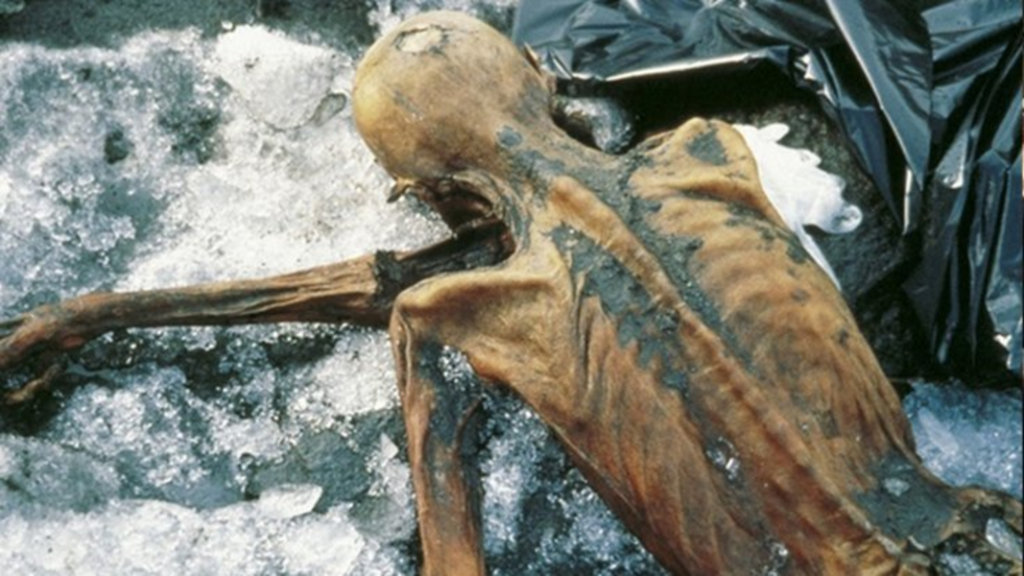During the last days of the summer of 1991, tourists hiking in the Ötztal Alps near the Italy – Austria border found the remains of an incredibly well-preserved man. This man, dubbed Ötzi, was dated back to the “Copper Age”: an informal name given to the transitional period between stone and iron working, or approximately 3500 to 2300 years ago. Incredibly, once the body was removed, it was found that Ötzi was actually carrying a toolkit – one of the most complete of its kind to be discovered. Recently, the tools found in Ötzi’s kit were analyzed to tell us more about Ötzi’s skills and how resources were obtained throughout Italy during the Copper Age.
Ötzi’s toolkit consisted of two arrowheads (not counting the one found in his body), multiple unfinished arrow shafts, a scraper (a rock used to remove thin sections of animal hide and wood), a borer (a tool used for making holes in softer material), and stones that could be used to make more arrowheads. Researchers studied the stone used to make the tools as well as CT scanned the tools to get a 3D form for each tool. These CT scans are important because they let the scientists compare the overall shape of each object and allowed for comparison between other Copper Age rock tools found throughout the area around Ötzi. The examination of the material used to make the tools was done to identify the makeup of each item as well as search for fossils. Since small fossils were located in the rock that comprised each tool, the authors could determine where the rock was originally gathered and date the stone.
Dating the fossils was done by comparing the types of fossils found in the rocks to others of a known age. If a fossil was known from a specific time period, a scientist could date the stone that contains the fossil to a particular date. Once the age of the stone is known, the tool can then be traced back to certain formations near the point of discovery. The age and original location of the stones used for tool making were based on small fossils found within the rocks themselves.
Each tool was made of chert, a type of rock that is frequently used in crafting ancient tools and weapons around the world. Since chert is what is known as a sedimentary rock – a rock type that is made by particles depositing on both land and in water – it frequently contains fossils that can easily be traced back to points in time and nearby locations. Many of the tools found with Ötzi contain tiny fossils that are found in the chert from nearby outcrops of rock. The dating of these fossils allow the tools to be traced to the Maiolica-Scaglia Variegata Alpina area, to the south of where Ötzi was discovered.
The researchers surmised that Ötzi lacked the tools that were used to make arrowheads, and the dulled chert items (e.g. the scraper) indicate that he did not have the skills needed to make stone tools by himself. The chert items could have easily been sharpened or remade by a skilled worker. The authors of this research paper point out that making tools is a time intensive activity which was better suited for people that specialized in hand making stone equipment during the Copper Age. The presence of different tools made of chert from different areas indicates that Ötzi obtained his tools from someone else – quite possibly a person that specialized in making the specialized tools Ötzi was carrying at the time of his death. If the tools were traded and obtained from a specialized tool maker, then this indicates that trade in rocks and tools was flourishing in Italy during the Copper Age.
The mystery around Ötzi’s death remains and may never be solved. However, small details about his personal life and trade in the surrounding area have been learned from his toolkit. We can guess that his equipment was supplied by others and that Ötzi lacked the knowledge and tools to make his own supplies. This shows the presence of different occupations during the Copper Age and that raw materials for tool making were gathered from a broad area rather than found during travel. The evidence provided by the authors show tool usage and care that is much like our own when you consider that many of us today have tools that are specialized and are personally maintained rather than re-manufactured when they break. Our similarity in tool care might be surprising considering the tools we might individually own today are much more complicated than those used by Ötzi. Yet, the principles of trade and production by specialized craftspeople is still very similar. Not much has changed in this respect throughout the millennia!


